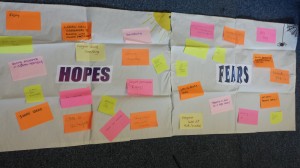If you’re new to this blog, our regional participation networks are suitable for anyone working in the field of participation and citizen engagement and we run them three times a year in North Wales, South East Wales and South West Wales. Attendees come from a range of different organisations in the public and third sector that focus on a variety of issues. The events are suitable for anyone from any level within an organisation that has an interest in practical participatory work, including consultation officers, trustees, volunteers, development workers and managers.
These regional participation networks are suitable for anyone working in the field of participation and citizen engagement.
The theme of the events that took place in Glyncoch, Llanelli and Rhyl in October was participative tools and techniques. The sessions offered an opportunity for participants to learn and practice a number of practical techniques that can be used in face to face engagement activity.
Here is a summary of some of the techniques that we explored and the ideas we discussed:
Hopes and fears
Aims: To identify participants’ hopes and fears.
Method: Ask participants to write down their hopes and fears. We used this as an extended ice-breaker to identify what people were hoping to get from the session and what they were afraid of. It’s also valuable to re-visit these at the end of the session, to check whether the hopes were met and the fears were addressed.
This technique is particularly useful to use at the start of a session because it allows the facilitator to manage expectations from the beginning; for example if anyone has ‘hoped’ for something which is not relevant or off-topic then this can be made clear. It may also be comforting for participants to see that others share the same ‘fears’ as them – the facilitator could also reassure anyone with legitimate fears relating to the session.
World’s best and worst
Aims: To draw attention to issues by looking at them in a dream/nightmare scenario. This can be both a visioning tool and a problem solving tool.
Method: Choose a topic that you want to explore and ask the group to imagine the absolute best and worst version they can imagine.
This technique is interesting because it allows the group to explore a situation by looking at it in its most extreme. It is also a very light hearted way of looking at serious issues. Following on from this – you could then move on to thinking about the process of how you achieve the ‘world’s best’ and how to avoid becoming the ‘world’s worst’!
For our network events, we chose the topic of neighbours: What does the world’s best/worst neighbour look like and what characteristics do they have?
Facts vs. Assumptions
Aims: To distinguish facts from assumptions and build awareness that what people identify as fact is often rumour or opinion.
While we were preparing for this technique we were mindful of how to distinguish facts from assumptions and we found it difficult to pick a topic to use for demonstration purposes. We decided to ask what participant’s assumptions were about Participation Cymru and then we were able to ‘myth-bust’ them, which was a lot of fun! Some participants assumed that we were a large team, when we are a team of just four.
We then asked attendees to volunteer to be the ‘fact keeper’ for their own organisations and we repeated the exercise with organisations from people in the room. This was a fascinating way of networking and learning about each other’s organisations and it prompted a lot of discussion at our network events.
If the topic you’re discussing is controversial then it should be used carefully as facts are not always straightforward – lots of people will see their opinions as facts. This tool could also be used in partnership working between organisations; we use it in our Effective Partnership Working accredited training course.
Attendees at the 3 events also shared their own favourite techniques, we always welcome contributions to our participation networks – if you ever have an idea/topic or would like to be involved in planning or delivery our networks then please get in touch.
To evaluate these network events we asked attendees to rate each technique on its usefulness using stickers on a 1-10 scale (combined results from all 3 events):
The next round of network events are in February 2015 and they are free to attend. More information will be available soon but you can book early to guarantee your place! Thank you for your continued support of these participation networks.
– Sarah





